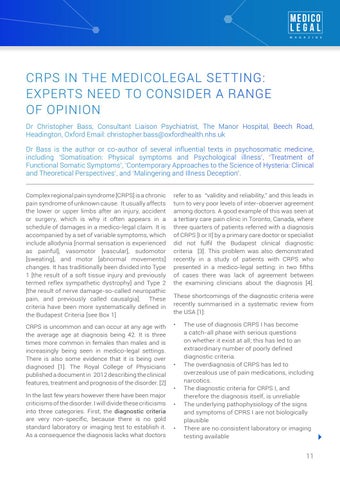MEDICO LEGAL M A G A Z I N E
CRPS IN THE MEDICOLEGAL SETTING: EXPERTS NEED TO CONSIDER A RANGE OF OPINION Dr Christopher Bass, Consultant Liaison Psychiatrist, The Manor Hospital, Beech Road, Headington, Oxford Email: christopher.bass@oxfordhealth.nhs.uk Dr Bass is the author or co-author of several influential texts in psychosomatic medicine, including ‘Somatisation: Physical symptoms and Psychological illness’, ‘Treatment of Functional Somatic Symptoms’, ‘Contemporary Approaches to the Science of Hysteria: Clinical and Theoretical Perspectives’, and ‘Malingering and Illness Deception’. Complex regional pain syndrome [CRPS] is a chronic pain syndrome of unknown cause. It usually affects the lower or upper limbs after an injury, accident or surgery, which is why it often appears in a schedule of damages in a medico-legal claim. It is accompanied by a set of variable symptoms, which include allodynia [normal sensation is experienced as painful], vasomotor [vascular], sudomotor [sweating], and motor [abnormal movements] changes. It has traditionally been divided into Type 1 [the result of a soft tissue injury and previously termed reflex sympathetic dystrophy] and Type 2 [the result of nerve damage-so-called neuropathic pain, and previously called causalgia]. These criteria have been more systematically defined in the Budapest Criteria [see Box 1]
refer to as “validity and reliability,” and this leads in turn to very poor levels of inter-observer agreement among doctors. A good example of this was seen at a tertiary care pain clinic in Toronto, Canada, where three quarters of patients referred with a diagnosis of CRPS [I or II] by a primary care doctor or specialist did not fulfil the Budapest clinical diagnostic criteria [3]. This problem was also demonstrated recently in a study of patients with CRPS who presented in a medico-legal setting: in two fifths of cases there was lack of agreement between the examining clinicians about the diagnosis [4].
CRPS is uncommon and can occur at any age with the average age at diagnosis being 42. It is three times more common in females than males and is increasingly being seen in medico-legal settings. There is also some evidence that it is being over diagnosed [1]. The Royal College of Physicians published a document in 2012 describing the clinical features, treatment and prognosis of the disorder. [2]
•
In the last few years however there have been major criticisms of the disorder. I will divide these criticisms into three categories. First, the diagnostic criteria are very non-specific, because there is no gold standard laboratory or imaging test to establish it. As a consequence the diagnosis lacks what doctors
These shortcomings of the diagnostic criteria were recently summarised in a systematic review from the USA [1]:
•
• •
•
The use of diagnosis CRPS I has become a catch-all phase with serious questions on whether it exist at all; this has led to an extraordinary number of poorly defined diagnostic criteria. The overdiagnosis of CRPS has led to overzealous use of pain medications, including narcotics. The diagnostic criteria for CRPS I, and therefore the diagnosis itself, is unreliable The underlying pathophysiology of the signs and symptoms of CPRS I are not biologically plausible There are no consistent laboratory or imaging testing available
11
